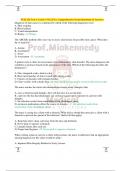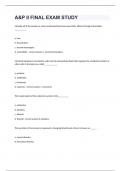NUR 155 Test 3 (Crisis 3 NCLEX), Comprehensive Exam Questions & Answers
Diagnosis of skin cancer is confirmed by which of the following diagnostic tests?
A. Skin scraping
B. Blood culture
C. Visual interpretation
D. Biopsy - D. Biopsy
The ABCDEs method offers one way to assess skin lesions for possible skin cancer. What does
the A stand for?
A. Actinic
B. Asymmetry
C. Arcus
D. Assessment - B. Assymetry
A patient visits a clinic for assessment of an inflammatory skin disorder. The nurse diagnoses the
condition as psoriasis based on the appearance of the skin. Which of the following describes the
dermatoses?
A. Flat, elongated scales, dark in color
B. Red, raised patches of skin covered with silvery scales
C. Clusters of pustules with irregular borders
D. Clear vesicles with a dusky base - B. Red, raised patches of skin covered with silvery scales
The nurse teaches the client who demonstrates herpes zoster (shingles) that
A. once a client has had shingles, they will not have it a second time.
B. a person who has had chickenpox can contract it again upon exposure to a person with
shingles.
C. the infection results from reactivation of the chickenpox virus.
D. no known medications affect the course of shingles. - C. the infection results from
reactivation of the chickenpox virus.
The nurse is caring for a client with a furuncle. What advice should the nurse give a client with a
furuncle to prevent the spread of the infection? (Select all that apply)
A. Keep hair short, clean, and away from the face and forehead.
B. Never pick or squeeze a furuncle.
C. Launder linens after each use.
D. Proper hand hygiene. - B. Never pick or squeeze a furuncle.
When writing a plan of care for a client with psoriasis, the nurse would know that an appropriate
nursing diagnosis for this client would be what?
A. Impaired Skin Integrity Related to Scaly Lesions
,B. Acute Pain Related to Blistering and Erosions of the Oral Cavity
C. Impaired Tissue Integrity Related to Epidermal Shedding
D. Anxiety Related to Risk for Melanoma - A. Impaired Skin Integrity Related to Scaly Lesions
A nurse is planning the care of a client with herpes zoster. What medication, if given within the
first 24 hours of the initial eruption, can arrest herpes zoster?
A. Prednisone
B. Azathioprine
C. Triamcinolone
D. Acyclovir - D. Acyclovir
A client has just undergone surgery for malignant melanoma. Which of the following nursing
actions should the nurse anticipate? (Select all that apply)
A. Education regarding incision care.
B. Perform daily skin self-skin exams.
C. Provide soft or liquid diet that is high in protein to assist with healing.
D. Anticipate the need for, and administer, appropriate analgesic medications - A. Education
regarding incision care.
Delirium - Reversible state of confusion-usually caused by a medical condition
Depression - Mood disorder; sense of hopelessness and persistent unhappiness
dementia - a gradual and irreversible loss of intellectual function
Hemiparesis - weakness on one side of the body
*damage from right side of the brain affects the left side of the body and vis versa
Types of sensory deficits and examples - Tactile: touch; peripheral neuropathy
Smell: Olfactory; anosmia
Taste: Gustatory; decreased gustatory cells
Hearing: Auditory; conductive hearing loss, sensorineural hearing loss, and presbycusis (age
related hearing loss)
Equilibrium: motion sickness or Meniere's disease
Vision: Visual; myopia, presbyopia (far sightedness-age related), cataracts (lens of the eye
affected), glaucoma (pressure on optic nerve), diabetic retinopathy (blood vessels of eye are
damaged due to diabetes), and macular degeneration
,If patient begins to complain of pair or if resistance to joint movement is met, range of motion
exercises should be_____ - Range of motion exercises should be stopped; never hyperextend or
flex a joint beyond position of comfort
page 560 safety practice alert
The nurse is preparing to provide wound care to a client with a stage 1 pressure injury. Which
dressing would the nurse expect to be prescribed in the treatment
of this wound?
1. Hydrogel dressing
2. Transparent dressing
3. Antimicrobial dressing
4. Calcium alginate dressing - 2. Transparent dressing
A stage 1 pressure injury is characterized by intact
skin with nonblanchable erythema. Dressings used to manage a stage 1 pressure injury include
transparent dressings, hydrocolloid dressings, or no dressing and leaving the wound open to air.
The wound should resolve without epidermal loss over a period of 7 to 14 days. Hydrogel
dressings are used to maintain a moist environment for wound healing. Calcium alginate is
absorbent and is used in stage 4 wounds or those with deeper tissue injury. Antimicrobial
dressings are used for pressure injuries that are infected.
Test-Taking Strategy: Focus on the subject, the wound dressing that is appropriate in the
treatment of a stage 1 pressure injury. Remember that dressing use is conservative in this type of
pressure injury, and includes the use of transparent dressings or no dressing. The wound is
expected to heal without epidermal loss over a period of 7 to 14 days.
The nurse in a long-term care facility is observing a nursing student provide foot care to a client
with diabetes mellitus. Which action by the nursing student would indicate a need for further
teaching?
1. The nursing student tells the client to avoid soaking the feet.
2. The nursing student dries the feet thoroughly, including in between the toes.
3. The nursing student advises the client to consult the physician or a podiatrist regarding nail
trimming.
4. The nursing student applies lotion to the dorsal and plantar surfaces of the feet and in between
the toes. - 4. The nursing student applies lotion to the dorsal and plantar surfaces of the feet and
in between the toes.
Clients with diabetes mellitus are at an increased
risk for impaired skin integrity related to peripheral neuropathy or vascular insufficiency. The
feet are at an increased risk for the development of wounds and some clients may be unable to
, thoroughly inspect the feet regularly due to impaired mobility or other impairments. Meticulous
foot care is necessary to prevent complications. The client's feet would
not be soaked to prevent maceration, or skin softening, as this increases the risk of infection.
Regarding nail trimming, a podiatrist or a physician's order may be necessary to trim the nails, as
a client with diabetes mellitus is at increased risk for infection if the skin were to be accidentally
cut. The feet need to be dried thoroughly, with special attention given to the areas between the
toes, as skin breakdown or ulcers can go undetected in this area. Lotion needs to be applied to the
dorsal and plantar surfaces of the foot. However, it would not be applied between the toes as this
area needs to be kept dry. Therefore, option 4 is the action by the nursing student that requires a
need for further teaching.
As the nurse, you are providing care for a client and notice tiny, pinpoint red or purple spots. It
would appropriate for you to document these spots as
A)mottling
B)petechiae
C)cyanosis
D)jaundice. - B) Petechiae
As they nurse, you are performing a physical assessment of a client and find an area of bluish
marbling. You should document this area as
A) flushing
B) mottling
C) ecchymosis
D) cyanosis. - C) Ecchymosis
Fibrin - connective tissue that deposits in injured area and becomes framework for cell repair.
Scab - consists of clots and dead/dying tissue and serves to aid hemostasis and inhibit
contamination of wound by microorganisms.
collagen - whitish protein substance that adds tensile strength to the wound.
Granulation tissue - translucent red, fragile, bleeds easily. Has network of capillaries increasing
the blood supply
Eschar - dried plasma proteins and dead cells
Scar - thick grey, fibrinous tissue
Keloid - in some dark-skinned individuals an abnormal amount of collagen is laid down,
resulting in a hypertrophic scar.
Clean wound - uninfected wound sin which there is minimal inflammation and the respiratory,
GI, genital, and urinary tracts are not entered. Primarily closed wounds.





